In a rush to shore up Asia-Pacific influence with a free-trade pact that excludes China, even if means accepting Japan’s unwillingness to alienate the farm lobby, the Trans Pacific Partnership is looking more like another NATO-style security pact than a true free-trade zone.
The US-led TPP has set a year-end deadline for concluding a pact designed to unite 12 Pacific rim nations in a free-trade zone calculated to tilt the Pacific toward US rather than Chinese hegemony. TPP proposes to do this by imposing membership requirements that Beijing can’t currently meet due to its heavy state control of major industries.
The TPP puts the US in direct competition against the China-led Regional Comprehensive Economic Partnership (RCEP) which seeks to create a free-trade zone encompassing China, Japan, S. Korea, India, Australia, New Zealand and the 10 ASEAN nations. Because of the large overlap in prospective memberships of the two pacts, the only real competition is between Washington and Beijing.
RCEP’s advantage is that it is focused on drastically reducing or eliminating tariff barriers while TPP seeks to impose strict limits on government involvement in business as well as impose stringent intellectual property protection laws — both of which remain anathema to a China reluctant to accommodate so much externally enforced transparency on its state-owned enterprises.
Since many of RCEP’s prospective members have already agreed to similar tariff reductions in conjunction with ASEAN, APEC or various bilateral pacts, China could bring RCEP to fruition within a relatively short time, essentially freezing the US out of what would then be the world’s biggest free-trade zone.
The main hurdle to a 16-member RCEP is Japan’s reluctance to alienate the US, especially at a time when it is facing aggressive Chinese stance on the dispute over the Senkakus. Recognizing that Japan’s current tilt toward the TPP may not last forever, the US has worked hard to pull Tokyo in by severely weakening TPP’s anti-tariff regime to let Japan join even while maintaining absurd levels of protection for the so-called five sacred precincts that include rice and about 600 other categories of food products.
Currently Japan has exclusionary tariffs on 9,018 products, of which about 586 are related to the food categories, of which the most important are rice, wheat, beef, pork, dairy products and sugar. If allowed to maintain tariffs on all 586 products Japan would only be able to eliminate tariffs on 93.5% of the goods in which it trades within the TPP zone.
That’s not far from the current TPP negotiating stance which the US has greatly softened since Japan signaled its intention to seek membership earlier this year. Some analysts believe that Japan can conclude negotiations if it eliminates tariffs on about 230 products. That can be achieved by eliminating mostly marginal products like beef tongue and rice crackers.
That would still leave in place Japan’s tariffs on the most politically-sensitive categories of rice, wheat, beef, pork, barley, dairy, even the red beans used to fill traditional mochi.
Japan is currently conducting a product-by-product study at identifying the products least likely to alienate the farming sector which has kept the ruling Liberal Democratic Party (LDP) in power for all but seven of the past 68 years.
“It’s very important (for the LDP and the government) to be able to say, ‘We protected the five important product categories,’” explained one LDP official.
A TPP pact may help bolster waning US influence over the Pacific rim. But if Beijing concludes RCEP, even without Japan, it is likely to become the more important free-trade zone since it would promote real trade growth by eliminating most tariffs on the important categories of protected food products. In turn, that could deal a blow to US influence and prestige in the region.


